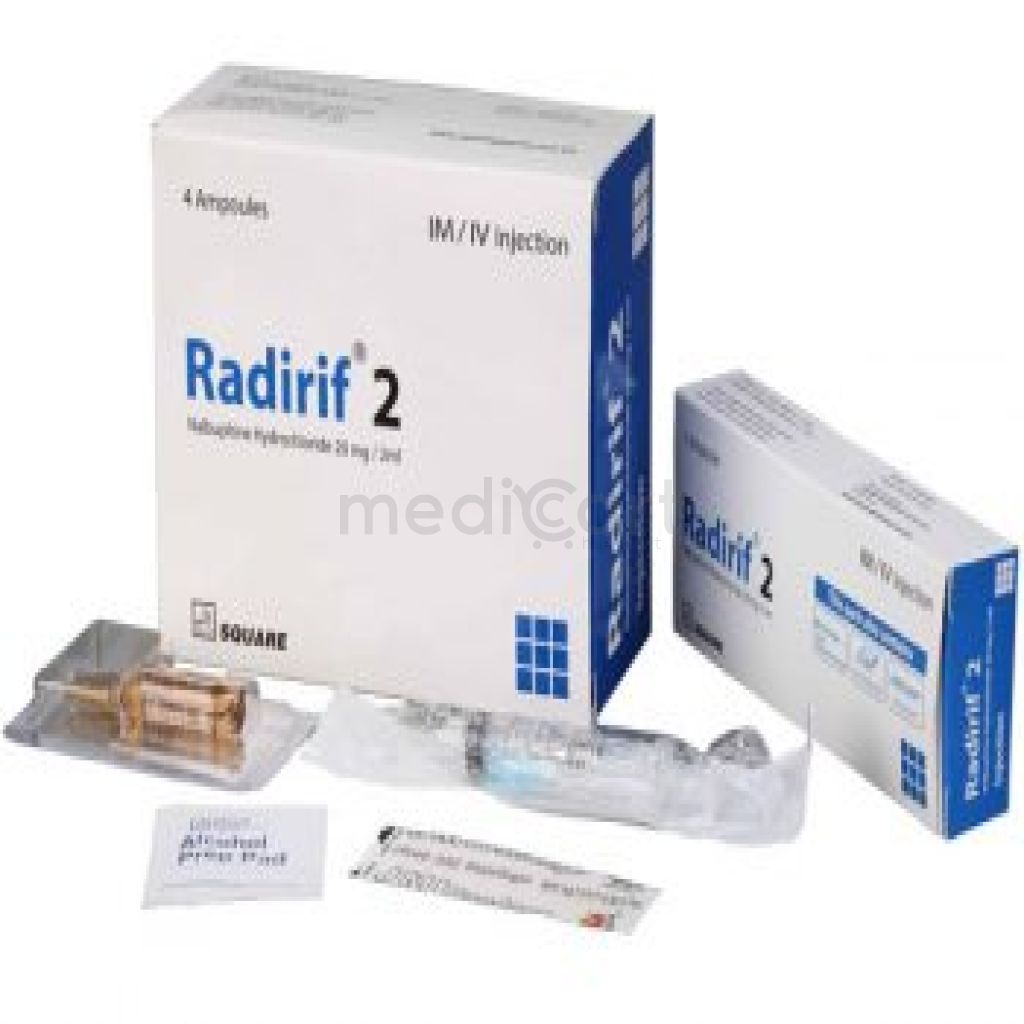

Radirif 20mg/2ml
Injection
Pack Size :
1 Injection x 1 Strip
Generics :
Nalbuphine Hydrochloride
Manufacturer :
Square Pharmaceuticals Ltd.
Best Price *
TK
100.68
* Delivery will be done in Dhaka city only.
More Information About - Radirif 20mg/2ml
Description
Generic Name
Nalbuphine HydrochloridePrecaution
May impair ability to drive or operate machinery. Emotionally unstable patients or patients with history of opiate abuse; closely monitor these patients during long-term therapy. Impaired respiration due to other drugs, uraemia, bronchial asthma, severe infection, cyanosis, respiratory obstruction. MI patients who exhibit nausea and vomiting and in those about to undergo biliary tract surgery. Head injury, intracranial lesions or pre-existing increased intracranial pressure. Renal or hepatic impairment. Elderly and debilitated patients. Pregnancy and lactation. Lactation: Insignificant amount distributed in milk; use with cautionIndication
Moderate to severe pain, Pain associated with MI, Balanced anaesthesiaContra Indication
Hypersensitivity. Absolute: Diarrhea associated with toxins, pseudomembranous colitis, respiratory depression (<12 beats/min) Acute asthma, bradycardia, inflammatory bowel disease, respiratory impairmentDose
N/ASide Effect
>10% Sedation (36%) 1-10% Clamminess (9%),Nausea and vomiting (6%),Dizziness (5%),Xerostomia (4%),Headache (3%) <1% Asthma,Bradycardia,Burning,Dyspnea,Hypertension,Hypotension,Itching,Miosis,Pulmonary edema,Respiratory depression,Tachycardia,Urticaria,Vertigo Potentially Fatal: Anaphylactic or anaphylactoid and other serious hypersensitivity reactions e.g. shock, respiratory distress, respiratory arrest, bradycardia, cardiac arrest, hypotension, laryngeal oedema.Pregnancy Category
Name : Not Classified
Description
FDA has not yet classified the drug into a specified pregnancy category.Mode of Action
Nalbuphine is a phenanthrene derivative opioid analgesic with mixed opioid agonist and antagonist activity. It inhibits the ascending pain pathways, altering the perception of and response to pain by binding to opiate receptors in the CNS. It also produces generalised CNS depression.Interaction
Additive CNS depressant effects may occur with other CNS depressants e.g. alcohol, anaesthetics, anxiolytics, hypnotics, TCAs and antipsychotics.Pregnancy Category Note
Pregnancy Prolonged use of opioid analgesics during pregnancy can cause neonatal opioid withdrawal syndrome; there are no available data in pregnant women to inform a drug associated risk for major birth defects and miscarriage; published studies with morphine use during pregnancy have not reported a clear association with morphine and major birth defects Prolonged use of opioid analgesics during pregnancy for medical or nonmedical purposes can result in physical dependence in the neonate and neonatal opioid withdrawal syndrome shortly after birth; the onset, duration, and severity of neonatal opioid withdrawal syndrome vary based on specific opioid used, duration of use, timing and amount of last maternal use, and rate of elimination of drug by newborn; observe newborns for symptoms of neonatal opioid withdrawal syndrome and manage accordingly Severe fetal bradycardia reported when administered during labor; naloxone may reverse these effects; although there are no reports of fetal bradycardia earlier in pregnancy, it is possible it may occur; drug should be used in pregnancy only if clearly needed, if potential benefit outweighs risk to fetus, and if appropriate measures such as fetal monitoring are taken to detect and manage potential adverse effect on fetus Labor or delivery Opioids cross placenta and may produce respiratory depression and psycho-physiologic effects in neonates; an opioid antagonist, such as naloxone, must be available for reversal of opioid induced respiratory depression in neonate; drug is not recommended for use in women during and immediately prior to labor, when use of shorter-acting analgesics or other analgesic techniques are more appropriate; opioid analgesics can prolong labor through actions that temporarily reduce strength, duration, and frequency of uterine contractions; however, this effect is not consistent and may be offset by an increased rate of cervical dilatation, which tends to shorten labor; monitor neonates exposed to opioid analgesics during labor for signs of excess sedation and respiratory depression Infertility Due to effects of androgen deficiency, chronic use of opioids may cause reduced fertility in females and males of reproductive potential; it is not known whether effects on fertility are reversible Lactation Morphine is present in breast milk; published lactation studies report variable concentrations of morphine in breast milk with administration of immediate-release morphine to nursing mothers in the early postpartum period with a milk-to-plasma morphine AUC ratio of 2.5:1 measured in one lactation study; however, there is insufficient information to determine effects of morphine on breastfed infant and effects of morphine on milk production; no information is available on effects of drug on breastfed infant or effects of drug on milk production The developmental and health benefits of breastfeeding should be considered along with mother?s clinical need for therapy and any potential adverse effects on breastfed infant from therapy or from underlying maternal condition Monitor infants exposed to therapy through breast milk for excess sedation and respiratory depression; withdrawal symptoms can occur in breastfed infants when maternal administration of morphine is stopped, or when breastfeeding is stoppedAdult Dose
Parenteral Moderate to severe pain Adult: IM/IV/SC: 10-20 mg 3-6 hrly as required. Non-opioid-tolerant patients: Max single dose: 20 mg. Max daily dose: 160 mg. Intravenous Adjunct in balanced anaesthesia Adult: Induction: 0.3-3 mg/kg over 10-15 min. Maintenance: 0.25-0.5 mg/kg as single admin if required. Hepatic impairment: Caution; dose reduction may be necessary; monitorChild Dose
Pain <1 year: Safety and efficacy not established >1 year: 0.1-0.2 mg/kg IV/IM/SC q3-4hr PRN; individual dose not to exceed 20 mg; not to exceed 160 mg/dayRenal Dose
Renal impairment: Caution; dose reduction may be necessary; monitorAdministration
IV Administration Administer each 10 mg by IV push over 3-5 minutesDisclaimer
The information provided herein are for informational purposes only and not intended to be a substitute for professional medical advice, diagnosis, or treatment. Please note that this information should not be treated as a replacement for physical medical consultation or advice. Great effort has been placed to provide accurate and comprehensive data. However, Medicart along with its authors and editors make no representations or warranties and specifically disclaim all liability for any medical information provided on the site. The absence of any information and/or warning to any drug shall not be considered and assumed as an implied assurance of the Company.






